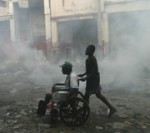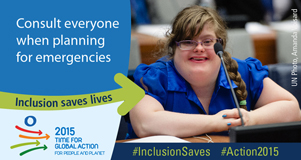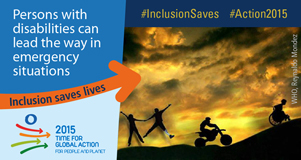
During the past decade, the world has witnessed an increase in the number of major disasters, such as the Asian tsunami in 2004, the Haitian earthquake in 2010, the Great East Japan Earthquake in 2011, and hurricane Sandy in the United States 2012. Persons with disabilities are disproportionally affected by conflict, disasters and other emergency situations. The Third United Nations World Conference on Disaster Risk Reduction (3WCDRR) taking place in Japan on 14-18 March, will address this issue.
Different populations, when exposed to similar risks of disasters and emergency situations, are affected in different ways. Factors such as poverty, social status, geographical location and access to mitigation and relief resources, influence the impact of disasters on each individual.
With early warning systems for disasters often not adapted to their specific needs, people with disabilities are especially at risk, resulting in a mortality rate two to four times higher than that of the non-disabled population, in many disaster situations.
Often overlooked, people with disabilities are a unique resource of knowledge and experience, essential to help reduce the risk of disasters and build resilient societies and communities. A barrier-free environment helps to ensure full and equal participation in society by all, regardless of age, gender or ability.
 To ensure the integration of persons with disabilities in the development of a global framework for disaster risk reduction, UN DESA’s Division for Social Policy and Development Division (DSPD) is working along with all stakeholders, including governments, UN system organizations, academics, the private sector, civil society organizations, and persons with disabilities and their organizations.
To ensure the integration of persons with disabilities in the development of a global framework for disaster risk reduction, UN DESA’s Division for Social Policy and Development Division (DSPD) is working along with all stakeholders, including governments, UN system organizations, academics, the private sector, civil society organizations, and persons with disabilities and their organizations.
Based on the first global framework on disaster risk reduction, the Hyogo Framework of Action (HFA) which concludes in 2015, the international community is moving forward with a post-2015 international framework on disaster risk reduction (HFA2) that will be adopted at the Third United Nations World Conference on Disaster Risk Reduction (3WCDRR) in Sendai, Japan, on 14-18 March. This framework will guide and support global efforts at all levels to build nations and communities that are resilient to disasters.
“Globally, over 1 billion people or 15 percent of the world’s population live with some form of disability,” Akiko Ito, Chief of the Secretariat for the Convention on the Rights of Persons with Disabilities said in a statement on the International Day of Persons with Disabilities in December last year. “Available data indicates that persons with disabilities experience disproportionately high rates of poverty and face exclusion and lack of equitable access to resources such as education, employment, health care and legal and social support systems.”
At 3WCDRR, the world will consolidate their expertise and efforts to adopt an agreement on a post-2015 framework for disaster risk reduction. But while international efforts are being made to create more resilient communities, a gap between the inclusion of persons with disabilities and the rest of society persists.

Also at 3WCDRR, DSPD will organize a public forum on 15 March event entitled “Taking action toward a disability-inclusive disaster risk reduction framework and its implementation”. At the Forum, stakeholders will conduct a review and assessment of existing policies and programmes, as well as the progress made and lessons learned for the advancement of disability inclusive disaster risk reduction at local, national, regional and international levels, drawing out concrete recommendations for the implementation of HFA2.
“A huge tsunami is coming in a minute, how do I know it is coming?” Akiko Fukuda, Secretary-General of the World Federation of the Deafblind asked delegates at a press conference in New York last December, illustrating the shortcomings of early warning signals that are broadcasts via mainstream and often inaccessible media such as television, radio or the internet. “I want to hear someone say ‘You are not alone’”, she added.
Institutional mechanisms and innovative technology have given policymakers more possibilities than ever before to include those with a disability in disaster risk reduction efforts. It is vital to ensure that these possibilities are fully developed and that persons with disabilities are included in both the design and implementation of future policy frameworks.
DSPD continues to work with all stakeholders to ensure that inclusive disaster risk reduction is prominently placed on the agenda in Sendai, and to remind governments, policymakers, civil society and the private sector that the inclusion of persons with disabilities in all aspects of disaster risk reduction efforts can save lives.
